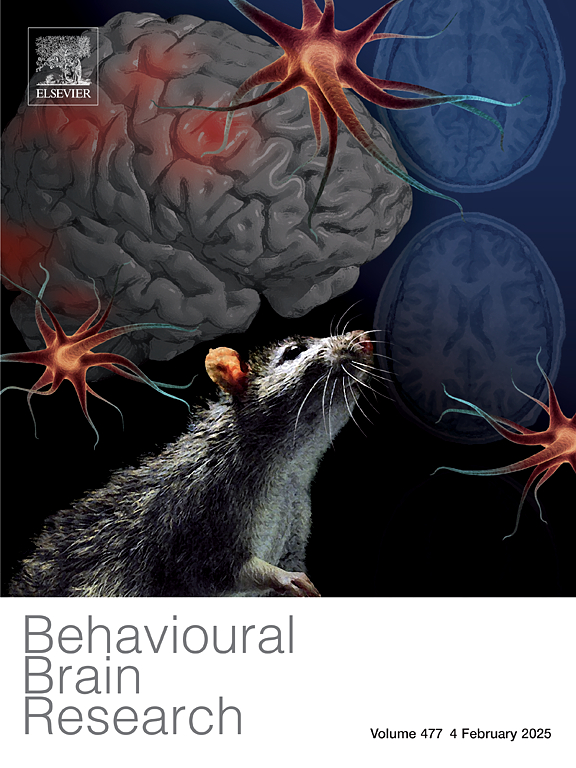Enhanced analgesia: Synergistic effects of melatonin and tramadol on acute thermal nociception in Wistar rats via tail-flick and hot-plate tests
IF 2.6
3区 心理学
Q2 BEHAVIORAL SCIENCES
引用次数: 0
Abstract
Background/aim
The aim of the study is to evaluate the antinociceptive effects of Tramadol+Melatonin [using Hot-plate (HP) and Tail-flick (TF) tests] at the behavioral level and to investigate its effects on motor coordination (using the Rotarod test) in acute pain.
Materials and methods
Thirty-two male Wistar albino rats, 8 weeks old and weighing 250–300 g, were used. The rats were randomly divided into four groups of eight animals each [Control, Tramadol (20 mg/kg), Melatonin (120 mg/kg), and Tramadol+Melatonin (20 mg/kg+120 mg/kg)]. The rats were trained to walk on the rotarod for 3 days prior to the experiment. Thermal acute nociception was assessed in rats using two TF tests and one HP test. Measurements were recorded before drug administration (baseline) and at 15, 30, 60, 90, and 120 minutes post-administration.
Results
Significantly higher values were obtained in both the HP and TF tests compared to the control, Melatonin, and Tramadol groups at various time points. In the Rotarod test, the baseline values of the Melatonin and Tramadol+Melatonin groups were significantly longer at certain post-administration time points.
Conclusion
The findings indicate a potential synergistic interaction between melatonin and tramadol, as evidenced by improved pain sensitivity thresholds. These results underscore the necessity for further clinical investigations to elucidate the therapeutic advantages and underlying mechanisms of this combination. Such research could significantly contribute to the development of more efficacious pain management protocols.
增强镇痛:通过甩尾和热板实验,褪黑素和曲马多对Wistar大鼠急性热痛觉的协同作用
背景/目的本研究的目的是在行为水平上评价曲马多+褪黑素的抗伤害感受作用[采用热板(HP)和甩尾(TF)试验],并探讨其对急性疼痛运动协调的影响(采用Rotarod试验)。材料与方法选用雄性Wistar白化大鼠32只,8周龄,体重250 ~ 300 g。将大鼠随机分为4组,每组8只[对照组、曲马多(20 mg/kg)、褪黑素(120 mg/kg)、曲马多+褪黑素(20 mg/kg+120 mg/kg)]。实验前,先训练大鼠在旋转杆上行走3天。采用2个TF试验和1个HP试验评估大鼠的热急性伤害感受。记录给药前(基线)以及给药后15、30、60、90和120 分钟的测量结果。结果与对照组、褪黑素组和曲马多组相比,HP和TF测试在各个时间点上的值都明显更高。在Rotarod测试中,褪黑素组和曲马多+褪黑素组的基线值在给药后的某些时间点明显更长。结论研究结果表明褪黑激素和曲马多之间存在潜在的协同作用,这可以通过改善疼痛敏感阈值来证明。这些结果强调了进一步临床研究的必要性,以阐明这种组合的治疗优势和潜在机制。这样的研究可以显著促进更有效的疼痛管理协议的发展。
本文章由计算机程序翻译,如有差异,请以英文原文为准。
求助全文
约1分钟内获得全文
求助全文
来源期刊

Behavioural Brain Research
医学-行为科学
CiteScore
5.60
自引率
0.00%
发文量
383
审稿时长
61 days
期刊介绍:
Behavioural Brain Research is an international, interdisciplinary journal dedicated to the publication of articles in the field of behavioural neuroscience, broadly defined. Contributions from the entire range of disciplines that comprise the neurosciences, behavioural sciences or cognitive sciences are appropriate, as long as the goal is to delineate the neural mechanisms underlying behaviour. Thus, studies may range from neurophysiological, neuroanatomical, neurochemical or neuropharmacological analysis of brain-behaviour relations, including the use of molecular genetic or behavioural genetic approaches, to studies that involve the use of brain imaging techniques, to neuroethological studies. Reports of original research, of major methodological advances, or of novel conceptual approaches are all encouraged. The journal will also consider critical reviews on selected topics.
 求助内容:
求助内容: 应助结果提醒方式:
应助结果提醒方式:


